This post may contain affiliate links. Please read our disclosure policy.
If you’ve seen my recipe videos on social media, you know I am all about the wok! I love the versatility that it provides, and the number one question I get asked is how to season a wok and maintain the wok‘s non-stick surface.
For anyone looking for a wok, I highly suggest purchasing a carbon steel wok. When properly seasoned and maintained, it provides a beautiful non-stick surface and builds a patina overtime.
If you can’t tell from the many appearances in my videos, my wok is one of my most-used kitchen tools! I have purchased and used many woks and the one I use now is my absolute favorite.
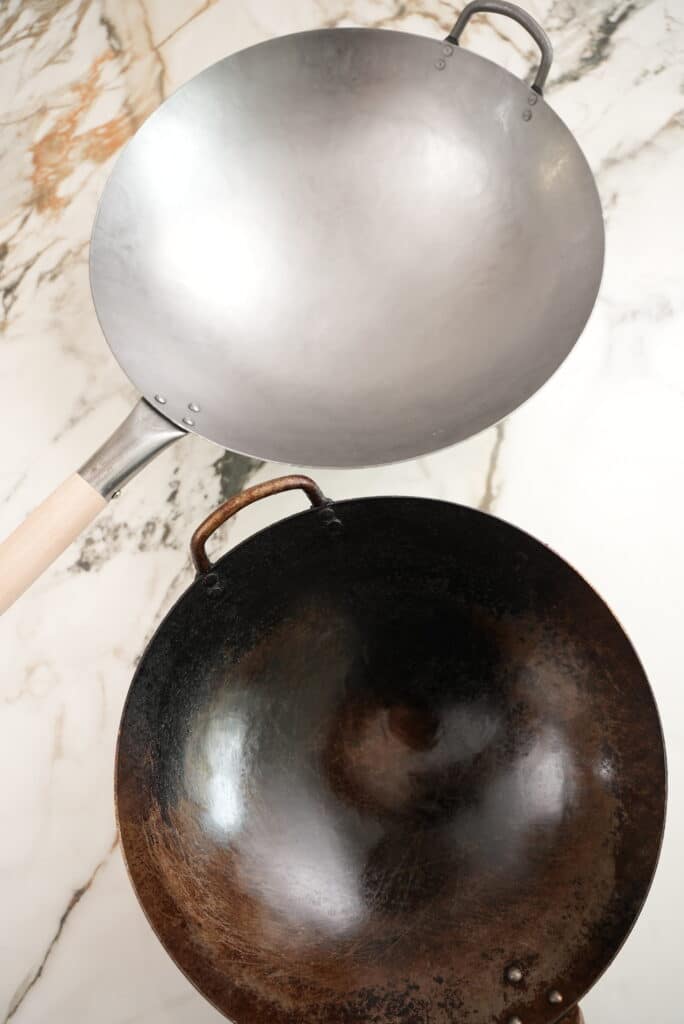
Watch How To Season a Wok in the Video Below!

Wok Overview 101
So you’re interested in cooking with a wok – great! You’re that much closer to achieving delicious restaurant quality food at home! But there are so many types of woks are on the market, and you might be confused which one to buy. Below is a brief overview of what makes a wok special and which one I recommend for your kitchen at home.
FIRST, WHAT IS A WOK?
- It’s a deep round-bottomed cooking vessel that is made from carbon steel or cast iron; it’s usually hammered by hand to create a specific angle & edge that makes it easier to push food up the sides of the wok.
- It’s believed to have originated from the Han dynasty of China, 202BC-220AD!
- It is SUPER VERSATILE – it can be used for a variety of cooking techniques, including pan frying, deep frying, stir frying, poaching, boiling, braising, searing, stewing, smoking, steaming, and roasting! It’s no surprise that it is one of the most used cooking tools in the world!
One of the biggest benefits (and one of my favorite reasons to use a wok) is WOK-HEI – this literally translates to “breath of the wok“. I would describe it as a unique and complex char, smoky flavor that can only be developed & achieved through wok cooking. Once you season your wok and it develops a patina of hardened oil that seals off the porous surface, the heat creates this incredible smokiness that makes your dishes THAT MUCH MORE DELICIOUS!
WHICH WOK SHOULD I BUY?
- If you have an ELECTRIC or INDUCTION STOVE, you should purchase this flat-bottomed wok – FYI, due to the hand made nature of the wok, it won’t be 100% flat. This is normal and expected (and a good sign that your wok is actually HANDMADE).
- If you have a GAS STOVE, you should purchase this round-bottom wok – I have a gas stove and this is the exact one I use now. On gas stoves, it’s recommended you purchase a wok ring to ensure your wok does not slide around while you are cooking. I don’t use one because I lift my burner grate and place my wok in place (see image).
When cooking with a wok, I strongly recommend using a wok spatula – it’s crucial to use a wok spatula, as it’ll be able to scrape up anything that might stick to the wok (and will add loads of flavor!) and help you handle all the food inside your wok. This is the one I personally use and I love the length and weight of it. I also use this wok ladle , depending on the dish.
How to Season Your Wok for the First Time
Your carbon steel wok will come with a factory seal of oils and residue from the manufacturer, so you will want to wash your wok for the first time with mild dish detergent and a soft sponge. If your handle is made of wood, ensure that you do not wash this part of the wok in an effort to prevent any warping of the handle.
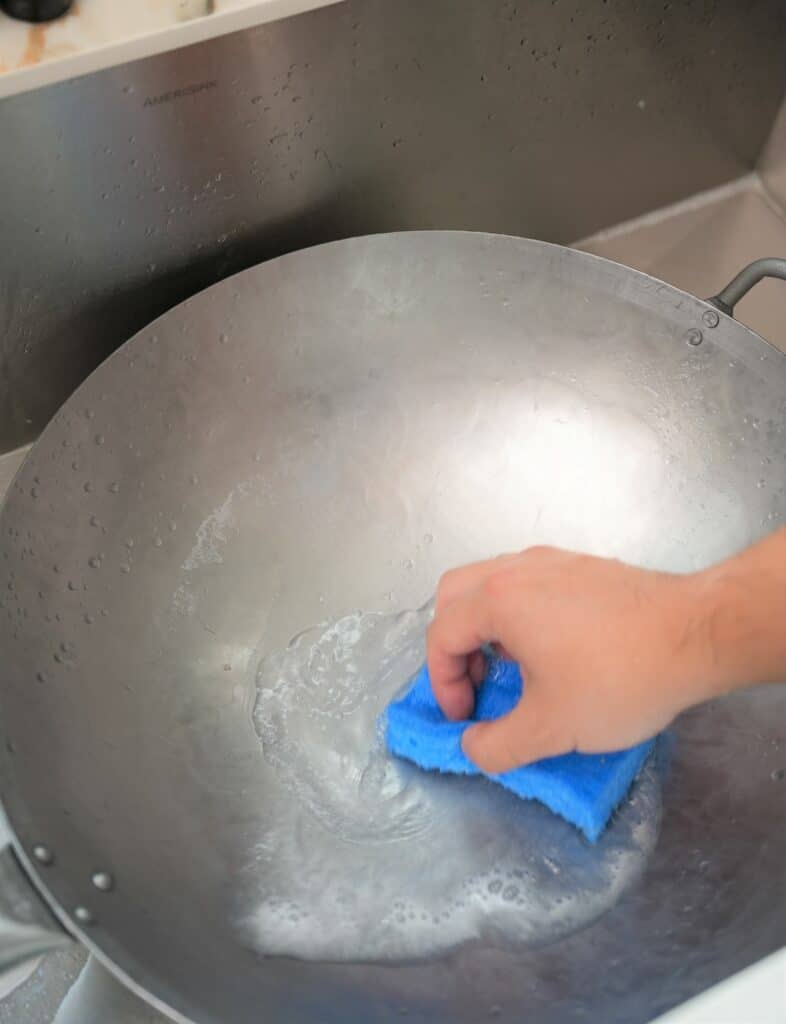
After the wok is washed, use a towel to wipe is completely dry and move it to your stove. Water is a carbon steel wok‘s WORST ENEMY! Water, if left on the wok to dry naturally, will rust your wok. The number one rule with a wok is never leave it wet!
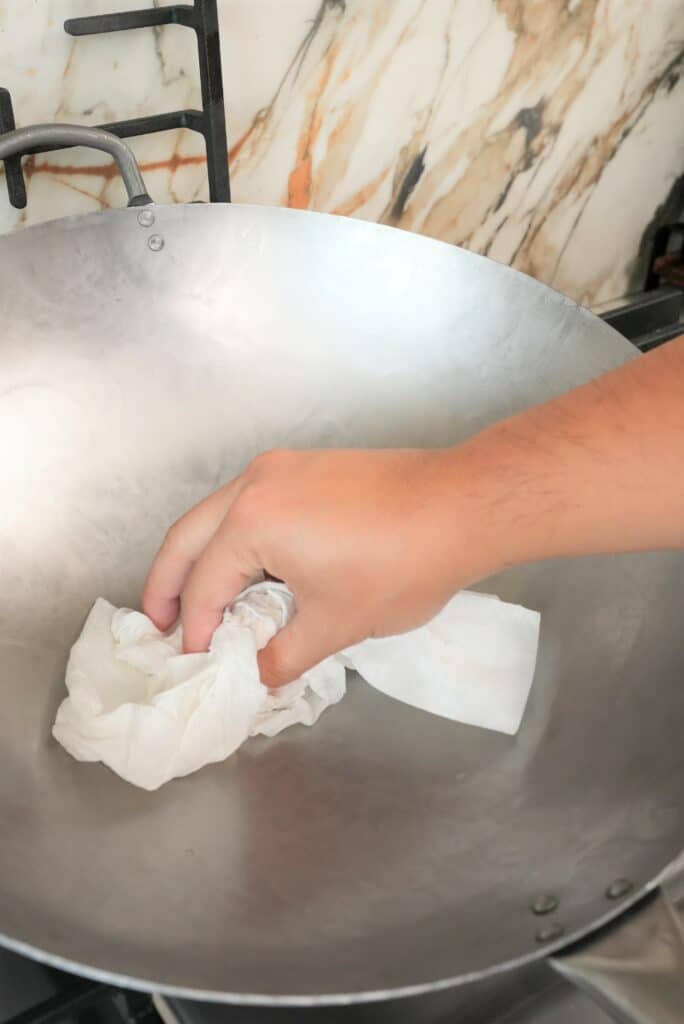
After a few minutes over the flame or induction burner, you’ll see the carbon steel begin to change color. It may turn to a dark brown or blueish color and begin to smoke. This means that the residual manufacturer oils are burning off.
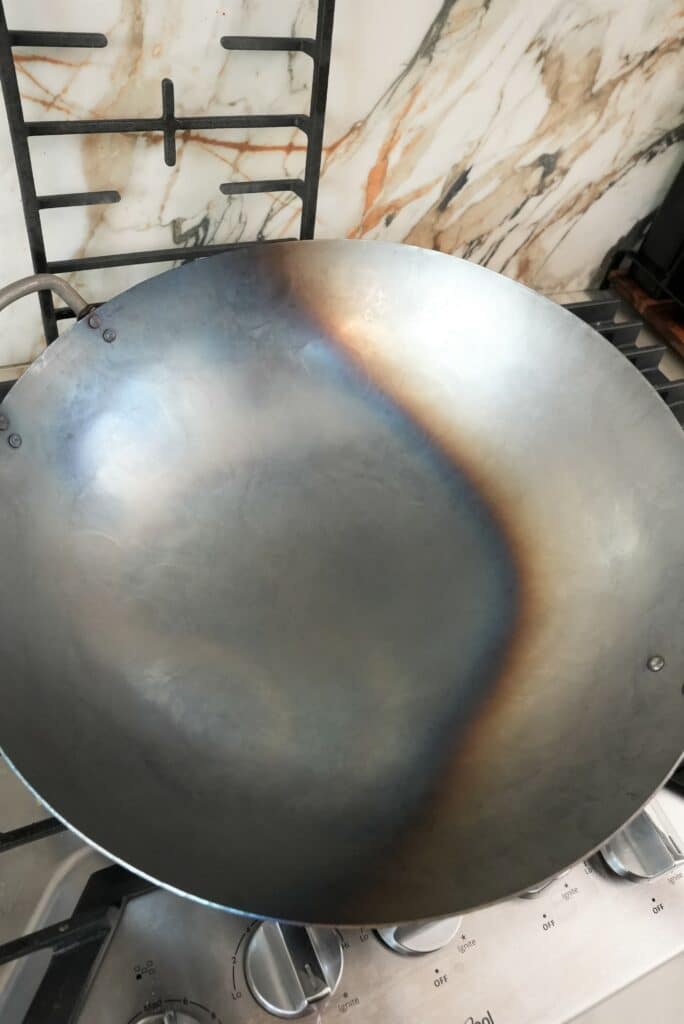
Continue heating the wok until the entire wok changes color. Tilt and rotate the wok as needed to ensure that all areas of the wok change color. The whole process should take about 10 minutes.

Once the wok has completely changed color, add about a tablespoon of neutral oil (canola, vegetable, or avocado oil works well), and tilt the wok so the oil spread evenly across the surface of the wok. Your wok will be hot, so expect some smoke here in this step.
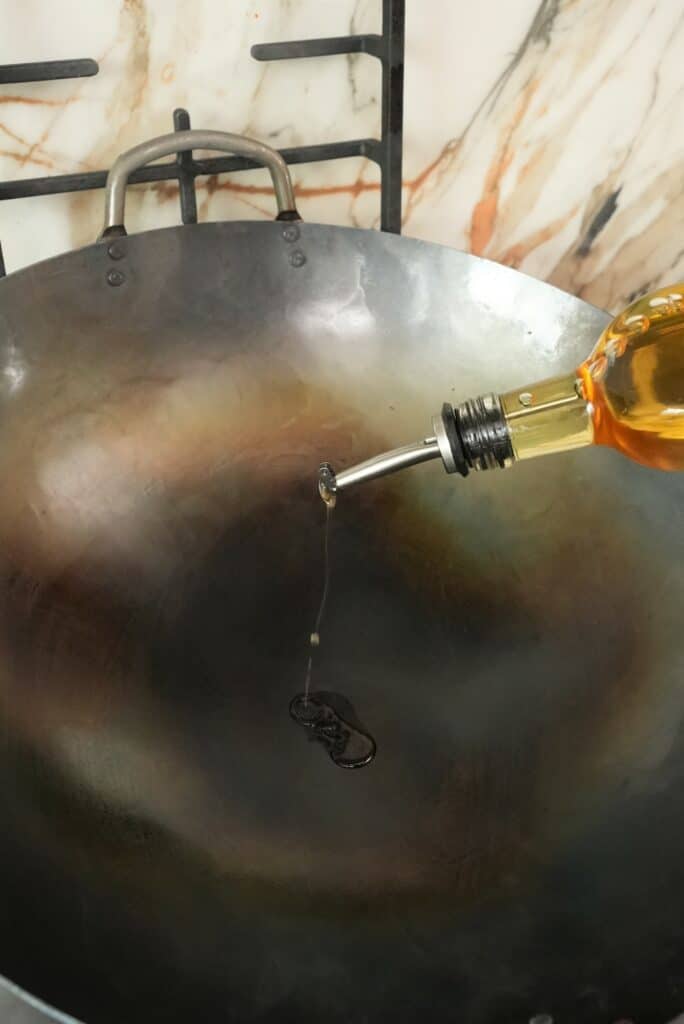
Using a paper towel, continue to spread the oil (be very careful here if using your hand, or use a wok ladle or tongs to handle the towel) until it is evenly coated throughout the surface of the wok. Then continue to heat the wok and incorporate the oil into the wok over medium low heat. You should see some smoke but more importantly, see the oil becoming a hard and slick/glossy surface forming on the wok. That is what’s known as the patina or layer of seasoning and is what help makes the wok non-stick!
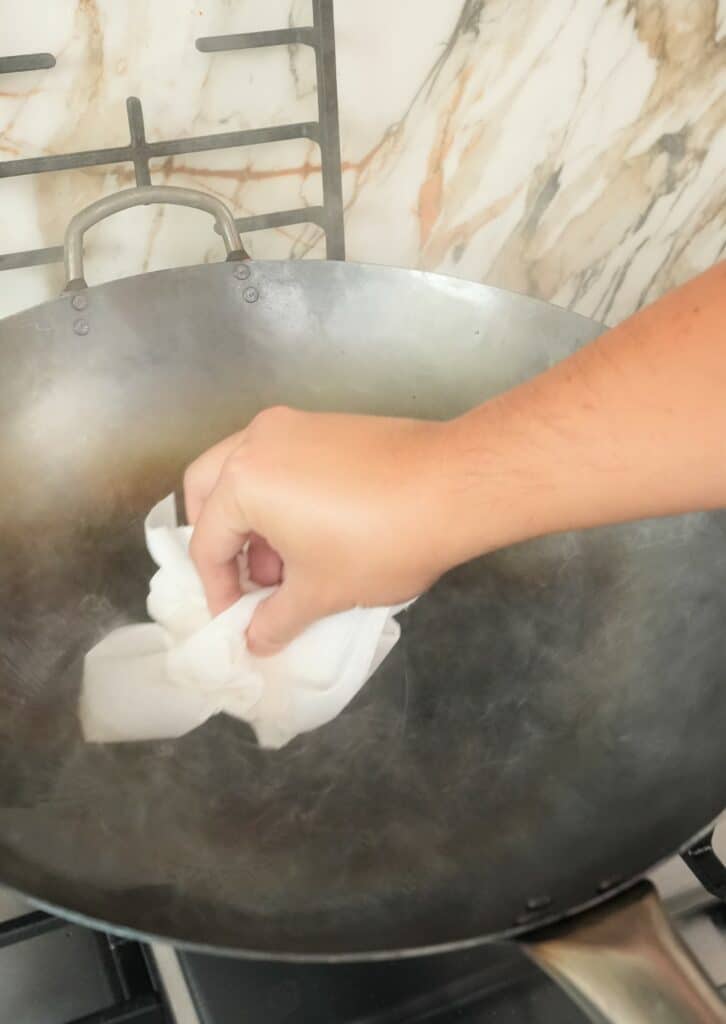
Then continue to heat the wok and incorporate the oil into the wok over medium low heat for another 3-5 minutes. Your wok is now ready to cook with!

Maintaining Your Wok
To properly maintain a carbon steel wok, you must keep it seasoned once the cooking process is done. After the wok is cooled, transfer it to your kitchen sink and rinse it with hot water, and use a soft sponge to scrub any residual food from the wok.

After the wok has been rinsed with water and there are no remaining food bits, wipe it completely dry and transfer it to your stove over high heat. Similar to the initial seasoning process, add oil and spread it evenly throughout the wok.

Wipe and spread it around your wok with a paper towel until you see the oil seep into the wok and there is no visible oil pooling at the bottom. Keep the wok over high heat for a minute or two until you see smoke, then turn the heat off. Let the wok cool and store it until you’re ready to cook again!

I hope this post on how to season your wok was helpful if you are new to wok cooking! If you are ready to cook, try some of my simpler dishes to practice cooking with your newly seasoned wok!
If you tried this Seasoning Your Wok or any other recipe on my website, please leave a 🌟 star rating and let me know how it went in the 📝 comments below!
How To Season A Wok
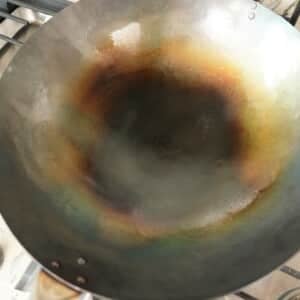
Equipment
- Wok (Round Bottom) Buy this if you have a gas stove!
- Wok Ring For Gas Stoves This will hold your wok in place over the gas burner (when your grates are removed)
- Wok (Flat Bottom) Buy this if you have an induction stove!
- Wok Ladle and Spoon These are high quality carbon steel tools I love!
Ingredients
- carbon steel wok, round bottom or flat bottom depending on your stove
- gas or electric stove
- neutral oil
- paper towel
- soft sponge with non-abrasive scrubber
Instructions
- Thoroughly wash your wok with hot water and mild dish detergent to remove the factory oil and residue. If your wok has a wooden handle, avoid getting the handle wet to prevent any warping of the wood. Wipe the wok completely dry.
- Set your wok on the stove over high heat. Heat all areas of the wok over the heat source until you see the carbon steel change color to a blueish color. Ensure all areas of the wok change color before proceeding to the next step.
- Add 1 tbsp of oil to the wok and carefully use tongs or a wok ladle to spread the oil evenly throughout the wok. Turn the heat down to medium low and continue heating until there is no visible oil left in the wok.
- Repeat this process after cooking with your wok to develop a greater layer of non-stick patina and have fun cooking!








Was able to properly season my wok with CJ’s vids!
Oh wow can’t wait to try!
Thanks for all the info!
@sab.sters
Help! We got a carbon steel wok supposedly pre-seasoned. We still seasoned it but ubsure if we have done it properly. Can we start all over again? We only washed with water then put on high heat, seasoned with oil and then high heat again until the smoke alarm was set off. How do we know we have done it properly?
Hi Hazel – you can test it by frying an egg in a small amount of oil and it should slide around easily! Remember to re-season it each time after use and the patina will build overtime!
Hi CJ! Your description of how to season and care for your wok was super helpful! I am now ready to order a wok, but what are your thoughts on the pre-seasoned carbon steel woks? I noticed Craft Wok has some that are pre-seasoned and only need to final seasoning. Thanks in advance for your help!
Hi Brooke! I recommend buying the unseasoned wok and seasoning it yourself. The layers you create during the first seasoning and overtime will be better than the pre-seasoned treatment that is included on those woks. I hope that helps!
Thank you for detailed instructions on seasoning! I do have one question: should I also season outside of the wok?
You’re so welcome! Yes, you can oil the outside and do the same process for the first time. I don’t find it necessary to do the outside every time after cooking, but you certainly can!
Yayyyy!!! Thank you so much for this blog post. Super helpful. I just got my new wok for Christmas and I’m so excited to use it! I hope all is well in your kitchen CJ. Thank you for your content
Where can I find your video on how to season your brand new wok?
I’m working on this one and hope to get it out soon!
still waiting for the “how to season” and care for your wok video 🙂
It’s coming – I promise!